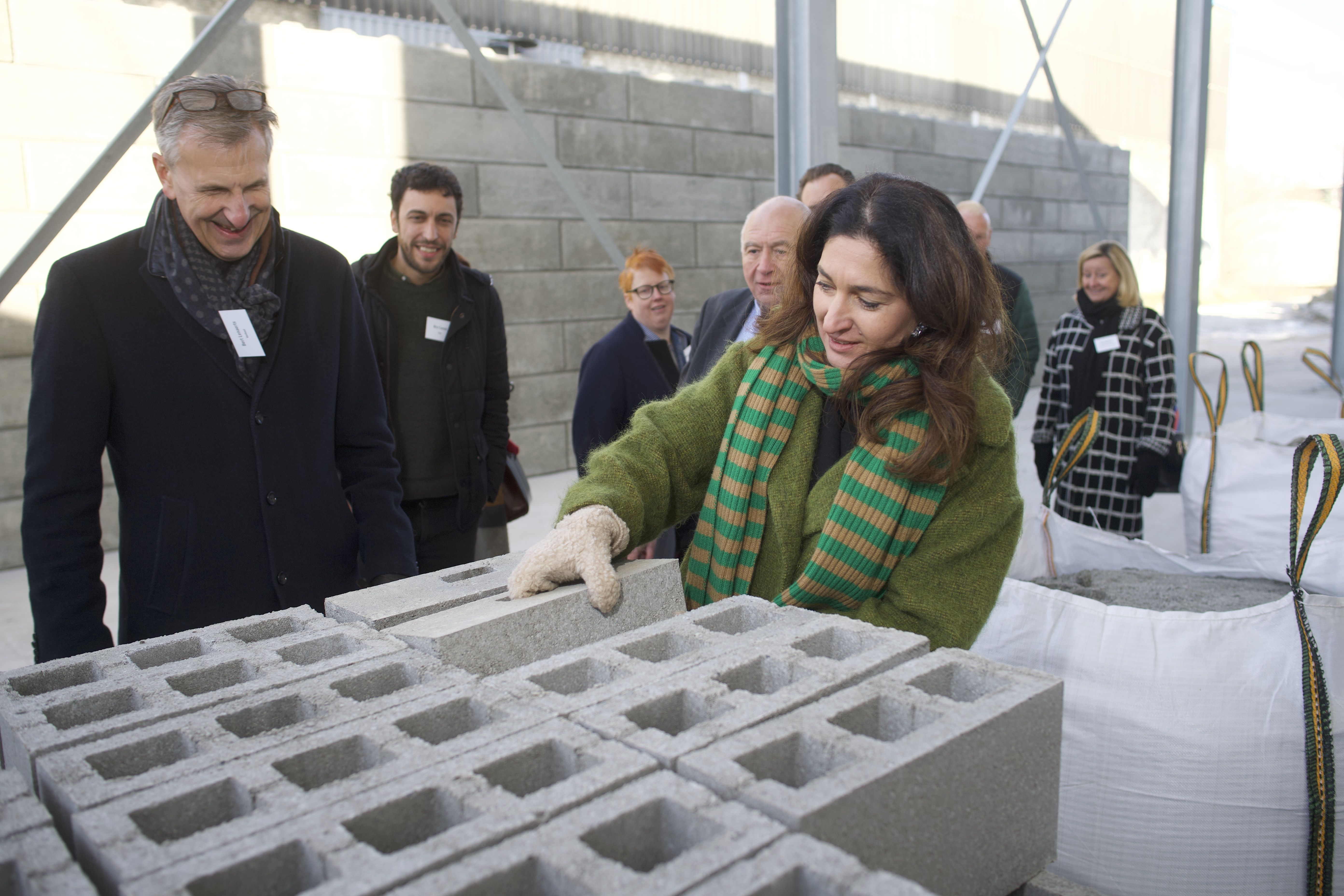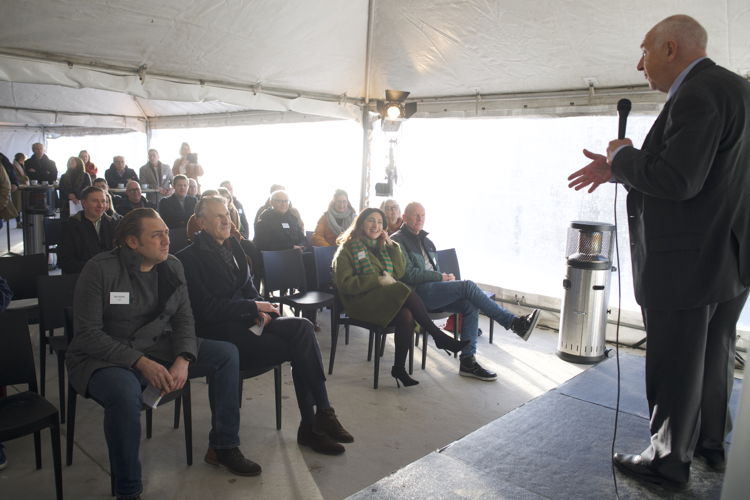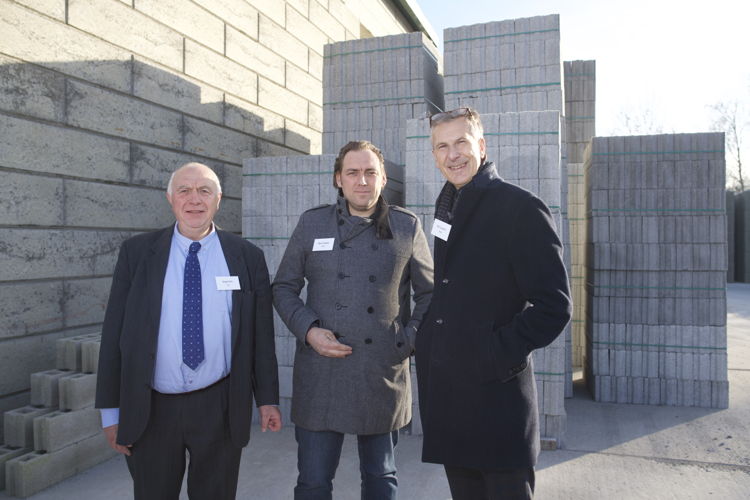Scoop: circular building blocks without cement... but with CO2
Masterbloc produces future-proof building blocks with Carbstone technology by Orbix
After years of research and lab work the first circular building blocks, using CO2 as a binding agent instead of cement, are a reality. Genk-based zero waste company Orbix and building materials producer Masterbloc from Maasmechelen succeeded in industrialising the Carbstone technology. As such the Limburg entrepreneurs are offering numerous sectors a future-oriented alternative to classic concrete bricks. Contractor Vanhout is currently using these circular blocks to renovate a Cofinimmo office building in Mechelen, which also houses the OVAM headquarters.

Carbstone: permanent CO2 storage
Building bricks that actually absorb CO2 during production instead of emitting it, and which themselves capture and retain CO2 from the air? This is not a pipe dream but reality: Masterbloc now produces sustainable interior wall bricks on an industrial scale based on Orbix's Carbstone technology. This means both companies have reached a new milestone and they are pulling out all the stops for circular construction with residual products from various industries.
Orbix's Carbstone technology, already patented in 2011, converts metal slag from steel production into value-added circular products using carbon dioxide. In this process CO2 acts as a binder and makes cement unnecessary - not insignificant, as cement production is responsible for some 10% of global CO2 emissions. Carbstone technology makes numerous CO2 negative and circular building materials possible, from tiles and clinkers over roof tiles and facing bricks to building blocks. Meanwhile, the first tonnes of future-oriented building blocks roll off the production line at Masterbloc.
Orbix CEO Serge Celis: "In the context of stricter environmental standards, rising CO2 emission allowances and the EU's zero-waste policy, Carbstone comes with a range of benefits. Not only does the process convert metal slag into an added value product, it also puts the CO2 emitted by companies to good use while providing permanent storage of a substantial amount of CO2. More and more companies are calling on our services, precisely because they are looking for a structural solution. Carbstone delivers revolutionary solutions with a negative CO2 footprint: during the production process more CO2 is absorbed than emitted. We are proud that today, after years of scientific research with such partners as VITO, we can take our technology from the lab phase to the industrial phase."
R&D Manager Dirk Van Mechelen is the godfather of the Carbstone technology within Orbix: "In 2004 we discovered that the finest residual fractions of steel slag harden under the influence of the limited CO2 concentration in the atmosphere. This process is based on the carbonatation of certain components of the slag. After intensive scientific research this resulted in a patented technology whereby this natural process can be accelerated in order to turn this fine residual fraction into high-quality building materials.So it’s a triple win: not only is this a useful solution for the residual fraction from the steel industry but at the same time you’re removing CO2 from the air and avoiding cement as a polluting production.”
The circular Carbstone blocks are a very efficient way of curbing emissions of this greenhouse gas. "Right, because you make optimal use of the capture, reuse and storage of CO2 - also known as Carbon Capture, Utilisation and Storage (CCUS). Moreover, the blocks are endlessly recyclable and Carbstone technology allows us to reuse more than just steel waste. Ash from incinerators or concrete rubble can also be combined with CO2 to make building materials. We continue to develop, expand and apply the technology so that we can offer a cost-efficient and environmentally-friendly solution to the CO2 problem”, Van Mechelen adds.
Flemish Minister of Environment Zuhal Demir: "The construction sector is responsible for 40% of CO2 emissions. So it is not surprising that the Flemish government mainly looks in the direction of construction companies when looking for partners to reduce our emissions. We do notice more and more that the construction sector itself wants to become part of the solution. Thus, pioneering companies, such as Orbix and Masterbloc, outline the possibilities for the future. Through technology and innovation, they pave the way for a more climate-friendly construction sector and livable Flanders."
First production of circular building blocks

With the step from lab and test plant to production plant, a major obstacle has been surmounted. With the first climate chamber in the Masterbloc plant in Maasmechelen, production today amounts to some 70 tonnes of CO2-bound building blocks per day, the equivalent of 15,000 tonnes on an annual basis. "But we will quickly increase that volume by building additional climate chambers”, says CEO Bjorn Gubbels. "We can apply Orbix's technology to efficiently transform steel slag into circular building blocks, that’s what counts.“
M. Gubbels sees a lot of advantages in this carbonatation. “First and foremost, you are of course helping to resolve the world’s CO2 issue. It goes without saying that circular building materials will not be able to eliminate all emissions, but we contribute to a significant reduction, precisely because cement production is the second largest CO2 polluter in the world. At the same time, it will enable Flanders to manage its raw materials much more efficiently – just think of all that sand and gravel recovered from millions of tonnes of steel slag and recycled and repurposed into something useful. An innovative example of upcycling! We have been working with Orbix for years to find new uses for the metal slag generated by the Aperam plant in Genk. Of course, the steel industry has expressed great interest in implementing the Carbstone technology. And last but not least, the prices of building materials will once again be able to stabilise because you’re working with a cement-free product with a fixed price and no longer have to depend on the cement industry.”
However, it will no doubt be quite a while before the construction market makes the switch from cement-bound to CO2-bound building bricks and blocks. “Of course, you have to convince your customers first. That shouldn’t be a problem, however, as you’re dealing with a product of equivalent quality and cost-controlled production, with the added benefit of circularity. Incidentally, if the blocks are ever ground down, all you are left with is sand and gravel as the CO2 is sealed for eternity. Just to give you an idea: with just one truck-load of building materials, the Carbstone technology can save as much as 10 tonnes of CO2, that is 5 tonnes of CO2 that are not released into the atmosphere because no cement is being produced, and an additional 5 tonnes because those sustainable bricks and blocks capture CO2 from the air and retain it.”
Of course, actually applying the Carbstone technology of Orbix on an industrial scale was quite a struggle. “It wasn’t always easy and it took a serious investment on our behalf but I would do it again in a flash. Precisely because it has such great potential for the future! With a number of feasible adjustments – such as a climate chamber to inject the CO2 under pressure – traditional concrete producers with traditional factories can also produce these circular blocks. Carbonatation in itself is a fairly simple process, which has already been in existence for more than one hundred years, but until now no one had succeeded in refining the technology into high-quality building blocks. We are so proud we were able to make it work.”
First renovation with circular building blocks in Mechelen
Vanhout Construction Group is also involved in the first application of circular, CO2-bound building blocks through the renovation of the Cofinimmo office building in Mechelen, which also houses OVAM's headquarters. CEO Bert Lenaerts: “Naturally we, too, are proud to contribute to this story in our capacity as a contractor. It’s a fine piece of pioneering work by Orbix and Masterbloc, with CO2 as a proven building block in the fight against climate change. It will only make the choice of building materials more important in the future.“
About Orbix
Headquartered in Genk, Orbix has been developing sustainable materials and innovative technologies for the construction and steel sectors for almost 30 years. As a circular entrepreneur and zero waste company, Orbix (from 'orbis', Latin for circle) strives for the optimal (re)use of materials. Today, Orbix has 130 employees across six sites in Belgium. The sites demetallise and valorise some 220,000 tonnes of metal slag every year. The R&D department in Genk invests in new applications and materials in close cooperation with such partners as VITO, knowledge institutes and various universities at home and abroad.
About Masterbloc
Founded 75 years ago, the third generation is currently at the helm of Masterbloc. Originally a local producer and supplier of building materials, the family business has meanwhile grown into a European specialist in the concrete sector - with the well-known stacking blocks as the basis for numerous internal and external walls, and roof structures. In addition to its headquarters in Maasmechelen, Masterbloc also has a branch in Riga, Latvia, that supplies the Northern European market.
For more details
Orbix nv I Serge Celis I +32 476 50 00 36 I serge.celis@orbix.be I www.orbix.be
Masterbloc I Bjorn Gubbels I +32 476 41 21 31 I bjorn.gubbels@masterbloc.be I www.masterbloc.be
RCA I Kirsten Van de Werf I +32 492 12 77 54 I kirsten.van.de.werf@rca.be I www.rcapress.be
Additional info - FAQ
What exactly are the components of Masterbloc’s circular building blocks?
The block contains 100% mineral residual fractions and therefore no cement. First of all, concrete is a hard building material consisting of sand, gravel, water and cement. In Masterbloc's circular building blocks, the cement component is replaced by Carbinox® from Orbix. Carbinox is a binder that can absorb CO2 from the air and carbonatate it. This fine material is released during the crushing and washing processes of slag granulates from the mineral fraction of stainless steel.
How does a classic concrete block differ from a circular building block from Masterbloc?
In terms of quality, there is no difference: both blocks are equally strong, dimensionally stable... In addition, Masterbloc's circular building block boasts excellent environmental performance. This sustainable block uses CO2 as a binder and eliminates polluting cement production and its high CO2 emissions. Moreover, this building block is not only made from waste products or secondary raw materials (steel slag and CO2), but can itself absorb CO2 from the air and retain it permanently.
Why did it take so long to industrialise Orbix's Carbstone technology?
The initial idea dates back to 2004 when R&D Manager Dirk Van Mechelen discovered that the finest residual fractions of steel slag harden under the influence of CO2. This process is based on the carbonatation of certain components of the slag. Orbix commissioned several knowledge institutes, including VITO, to determine the optimal boundary conditions for carbonatation. These scientific studies and practical tests in climate chambers took quite some time, eventually leading to a patented Carbstone technology in 2011. Orbix continued to develop, refine and expand the technology to make it widely applicable. Other important trajectories included exploring the various options for capturing industrial CO2 and certifying a commercial quality product.
When can we look forward to the international commercialisation?For this Orbix works closely with five key actors. This way the technology can be elaborated and refined to perfection, eventually finding applications in different markets. For instance, brick maker Vandersanden is currently building a CO2 negative facing brick factory and a cooperation agreement is already in place with Tubobel in Tessenderlo and Prefer in Liège, producers of concrete products for sewerage, drainage, sleepers and water treatment.


